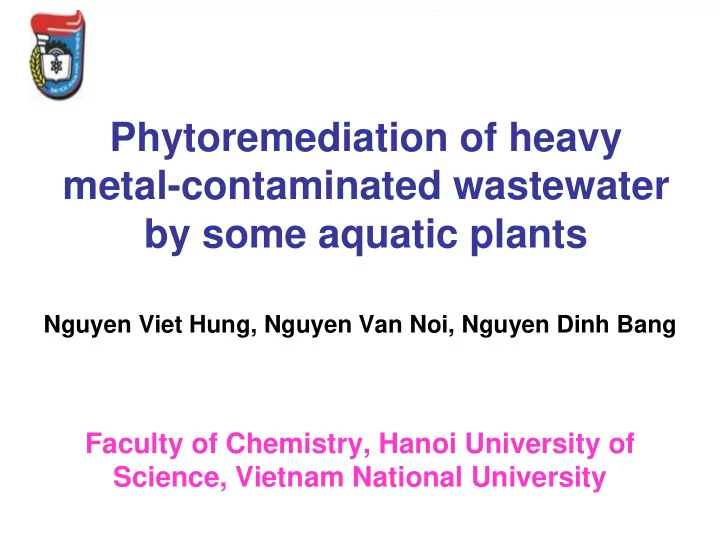

Phytoremediation of heavy metal-contaminated wastewater by some aquatic plants Nguyen Viet Hung, Nguyen Van Noi, Nguyen Dinh Bang Faculty of Chemistry, Hanoi University of Science, Vietnam National University
Introduction ! With her “ Open door ” policy, Vietnam is on the way of industrialization and modernization. ! Recently, living standard of Vietnamese has been improved considerably. However, environmental pollution has also become a concerning problem in Vietnam. ! Heavy metal-contaminated wastewater has posed threats to public health in many areas of the country ! In this study, phytoremediation--an environment-friendly method--was tested for feasibility in treatment of metal contaminants
Sources of heavy metal pollution in Vietnam ! Mining activity – spread of mine spoil and tailings and, in some cases, by the use of heavy metals in ore processing, e.g. the use of mercury in gold mining ! I ndustrial activity the processing and reclamation of metals by industry has led to the widespread contamination of soils and water ! Wastewater reuse due to the lack of treatment and the mixing of industrial and domestic wastewaters ! Fertilizers containing various trace metals
Advantages of Phytoremediation ! Phytoremediation is cheaper than conventional treatment approaches such as incineration and soil washing ! Phytoremediation may increase the slow pace of hazardous waste cleanup. More sites may be cleaned up simultaneously ! Phytoremediation leave topsoil in usable condition and reduce the amount of contaminated material to be landfilled or incinerated. Phytoremediation makes landscape ! acceptable for neighboring residents
Potential of applying phytoremediation in Vietnam ! Vietnam, a tropical country, has a vast biodiversity of flora ! Many aquatic plants (submersed, emersed and floating) are capable of cleaning organic contaminants from polluted water. Moreover, inorganic contaminants (including heavy metals) can also be treated (remove, transfer, stabilize, and destroy) by using different aquatic macrophytes.
Selected aquatic plants ! Water hyacinth ( Eichhornia crassipes ) ! Water lettuce ( Pistia stratiotes )
Heavy metal contaminants, experimented with phytoremediation in this study ! Pb 2+ ! Cu 2+ ! Ni 2+ ! Cr 6+ ! Cr 3+
Industrial wastewater discharge standards According to the Vietnam Standards TCVN 5942-1995 Limitation values N o Parameters Unit A B C 1 Lead mg/l 0.1 0.5 1 2 Copper mg/l 0.2 1 5 3 Nicken mg/l 0.2 1 2 4 Chromium (VI) mg/l 0.05 0.1 0.5 5 Chromium (III) mg/l 0.2 1 2 6 Mercury mg/l 0.005 0.005 0.01 7 Arsenic mg/l 0.05 0.1 0.5
Experimental Design ReferenceTank Experimental Tank Water lettuce Magnetic Stirrer
Picture of the experimental tank with water lettuce
Analytical methods ! Water samples (from both experimental and reference tanks) were analyzed ! Samples underwent filtration and acidification steps prior to AAS analysis ! Calculation of concentrations of metal contaminants in samples were based on the pre-established calibration curve
Obtained results 2+ (mg/l) 14 12 Concentration of Pb 10 8 Reference tank 6 Experimental tank 4 2 0 0 1 2 3 4 5 6 Time (days) Temporal change of Pb concentration in the phytoremediation experiment using water hyacinth
Obtained results 6 Concentration of Cu 2+ 5 4 (mg/l) Reference tank 3 Experimental tank 2 1 0 0 1 2 3 4 5 6 7 Time (days) Temporal change of Cu concentration in the phytoremediation experiment using water lettuce
Obtained results 2+ (mg/l) 6 5 Concentration of Ni 4 Reference tank 3 Experimental tank 2 1 0 0 1 2 3 4 5 6 7 Time (days) Temporal change of Ni concentration in the phytoremediation experiment using water lettuce
Obtained results 2+ 6 2+ & Cu 5 4 Concentration of Cu Concentration of Ni (mg/l) 3 Concentration of Ni 2 1 0 0 1 2 3 4 5 6 7 8 9 Time (days) Temporal change of concentrations in mixture of Ni and Cu during the phytoremediation experiment using water lettuce
Obtained results 12 3+ (mg/l) 10 Concentration of Cr 8 Experimental tank 6 4 2 0 0 1 2 3 4 5 6 7 8 9 10 11 12 Time (days) Temporal change of concentration of Cr (III) during the phytoremediation experiment using water lettuce
Conclusion ! Obtained results show that water hyacinth and water lettuce can be applied effectively to treat wastewater containing heavy metal contaminants at concentrations less than 10 mg/l. ! Phytoremediation with its proved advantages is very suitable for Vietnam, which has abundant and bio-diversified aquatic plants
Recommend
More recommend